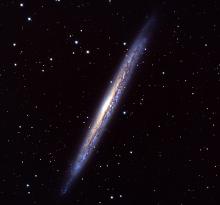Listen to today's episode of StarDate on the web the same day it airs in high-quality streaming audio without any extra ads or announcements. Choose a $8 one-month pass, or listen every day for a year for just $30.
You are here
Draco Dwarf
Our galaxy is so big and heavy that more than 50 smaller galaxies revolve around it. One of the first of these galactic satellites to be seen was discovered in 1954. Albert Wilson, an astronomer at Lowell Observatory in Arizona, was examining pictures of the constellation Draco, the dragon, when he noticed a faint smudge of stars. The stars belong to a small, faint galaxy that’s just 250,000 light-years away.
Like the Sun, the Draco dwarf galaxy orbits the center of the Milky Way. It’s so far out, though, that it takes between a billion and two billion years to complete just one circuit. The little galaxy’s orbit is stretched out, and it’s tilted at a steep angle to the Milky Way’s disk.
The stars in the Draco galaxy are few and faint. All together, they emit less light than the single brightest star in the Milky Way. In fact, for a long time Draco was the puniest galaxy known. And it has no gas with which to make new stars, so it’s not going to get any brighter.
In recent years, though, astronomers have spotted lots of even fainter galaxies orbiting the Milky Way. So the Draco dwarf is no longer the least luminous galaxy known.
The Draco galaxy is far too faint and spread out to see even through a telescope. But you can spot its location in the sky. The celestial dragon curls across the northeast at nightfall right now, to the right of the Little Dipper. The Draco galaxy is near the four stars that outline the dragon’s head.
Script by Ken Croswell




